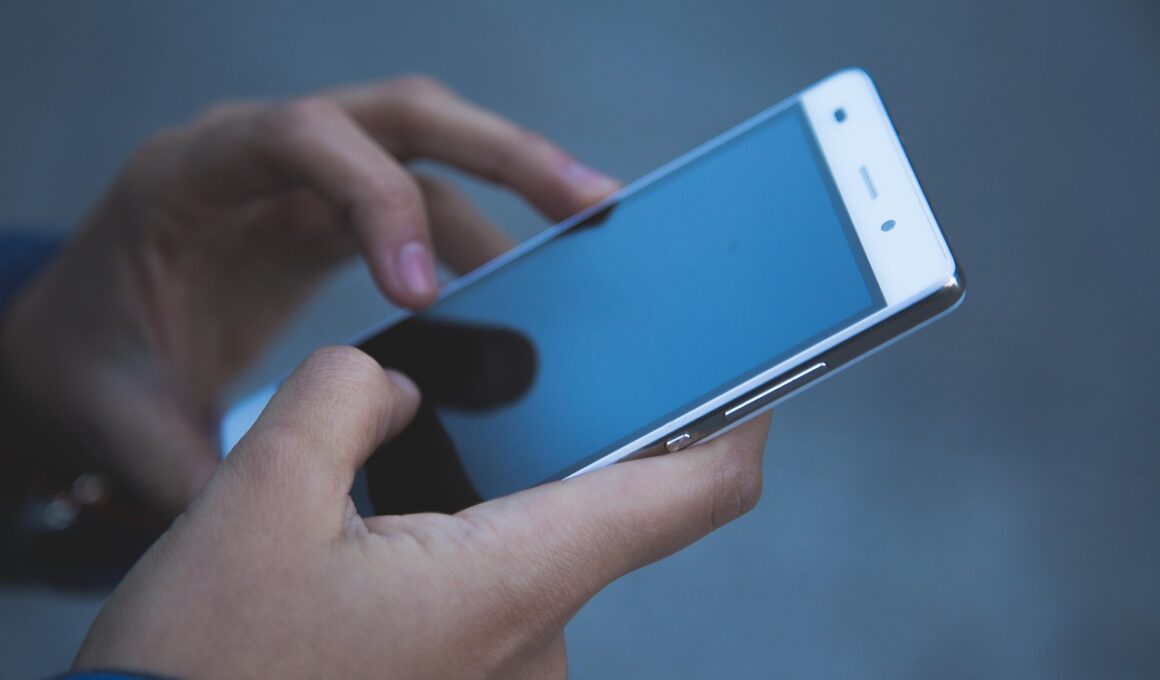Travel Tips for Maintaining Ergonomic Mobile Device Use
Traveling while using mobile devices requires attention to ergonomics for your physical health. Begin by considering your posture, which is crucial during long periods of device usage. To maintain a neutral spine, try to sit back while using your device and avoid slouching. If you’re using a phone, hold it at eye level to minimize strain on your neck. Additionally, consider investing in a portable phone stand that allows you to maintain proper posture. Regular breaks are essential to reduce muscle fatigue and eye strain that often accompany prolonged usage. Whenever possible, take short breaks every 20-30 minutes to stand and stretch. This simple habit can significantly enhance your comfort level while traveling. Staying hydrated is another critical factor, so remember to drink plenty of water, as dehydration can lead to fatigue and discomfort. You might also consider using a mobile device with a larger screen for a better viewing experience and reducing the need to squint. Finally, be mindful of your surroundings for safety while using your device, especially in busy areas or while walking, as distractions can lead to accidents.
Choosing the Right Accessories
When it comes to using mobile devices ergonomically while traveling, the right accessories can make a significant difference. Consider a lightweight, ergonomic case that offers extra grip and prevents your device from slipping out of your hands. A stylus can also serve as a valuable accessory, allowing you to navigate the screen without unnecessary finger strain. Invest in a comfortable mobile keyboard if you’re planning on typing extensively; these can help position your hands more naturally. If you wear glasses, ensure they are clean, as a clear screen reduces eye strain. Additional accessories, such as portable chargers, are also helpful to keep your device operational throughout long trips. Don’t hesitate to use noise-cancelling headphones if you’re in a noisy environment, as this can help you focus on your task without distractions. For longer travels, consider a lap desk, which can create a more stable surface for your device and make prolonged usage more comfortable. You should also tailor your accessories to your specific travel needs, ensuring they complement your routine and keep you comfortable during your mobile device usage.
Creating an ergonomic workspace while on the go can be a game changer. If you’re traveling by train or plane, try to secure a seat that provides little distraction and offers enough space to stretch your legs. Finding a stable surface is critical; a tray table works well for temporary workstations when traveling. Position your mobile device and other accessories strategically to ensure they are within easy reach and do not strain your body. Rest your forearms on the table or your knees to relieve wrist strain as you type or interact with your screen. Avoid using your mobile device in awkward positions that force your neck into uncomfortable angles. It’s similarly important to adjust your seating position regularly. Experiment with different postures, leaning slightly back and then forward throughout your trip to keep your body engaged and comfortable. Take the time to notice how your body responds to various positions; this awareness can inform better choices moving forward. Additionally, keeping your legs uncrossed while sitting helps maintain good blood circulation, which is vital during long periods of usage.
Mind Your Screen Time
Monitoring your screen time is another vital tip for maintaining ergonomic health while traveling. Engaging for too long with your mobile device can lead to conditions such as eye strain, known as digital eye fatigue or Computer Vision Syndrome. Setting time limits for checking your phone or device can ensure you take regular breaks. Tools and apps are available that can help you track your screen usage; be proactive in managing your time. Remember to practice the 20-20-20 rule: every 20 minutes, look away from your screen at something 20 feet away for at least 20 seconds. This technique helps to refresh your eyes and reduces the risk of straining. Consider downloading audiobooks or podcasts, which can give your eyes a rest while still engaging your mind. Listening rather than reading on your device not only reduces screen time but also provides variety in your travel experience. Making these adjustments in your mobile device habits while on the go will contribute positively to your overall comfort and health, allowing you to focus on enjoying your journey.
Physical activity is essential when using mobile devices, even while traveling. Incorporate stretches or light exercises into your travel day, particularly if you’re spending long hours with your device. Focusing on stretches for the neck, shoulders, and wrists can alleviate strain caused by prolonged device use. Simple neck-side stretches can help ease muscle tightness that accumulates from looking down at your device for too long. Another helpful stretch is the wrist flexor stretch, which involves extending your arm while pulling back your fingers with the other hand. You can also engage your legs with various seated exercises while on public transportation or during layovers, such as ankle circles or toe raises. Engaging in such movements helps keep blood flowing, reducing discomfort associated with long periods of sitting. After traveling for extended durations, dedicate time to conduct a thorough stretching routine after arriving at your destination. Making these physical activities a part of your travel routine can counteract the effects of sitting, improving your overall mobility and comfort while using mobile devices.
Awareness of Ergonomic Principles
Understanding and applying ergonomic principles can significantly improve your mobile device experience while traveling. Awareness of how your body responds to different usage contexts will allow you to adjust accordingly. Developing an awareness means being proactive about your posture, device placement, and break schedules. An effective way to maintain good ergonomics is to regularly assess your body’s comfort level. If you start feeling discomfort, it’s essential to reassess your posture and surroundings. Is your device at a comfortable angle? Do you need to shift positions? Plan your device usage around activities that naturally allow good posture, such as sitting at a table rather than slumping over your device in your lap. Furthermore, ensure your seating arrangement promotes good posture; consider using a cushion for additional support if necessary. Awareness extends beyond physical comfort to incorporate mental health aspects; traveling can induce stress, and finding time for enjoyment throughout your trip is vital. Balancing ergonomic practices with mindful enjoyment contributes to a positive travel experience while connecting with your mobile devices.
In conclusion, adapting ergonomic practices while traveling with mobile devices is crucial for physical health. Attention to posture, screen time, and taking breaks can make a significant difference in comfort levels during your journeys. The right accessories and monitoring of your device usage contribute to a better experience as well. Integrating stretches and staying active while on the move can alleviate stiffness and enhance overall well-being. A proactive approach to ergonomics will help your body withstand the demands of travel, enabling you to enjoy your trips more fully. Lastly, always remain aware of your ergonomic practices and adjust them based on how your body responds. If you experience discomfort, don’t hesitate to change your position or take a break. The journey should be enjoyable, and implementing these ergonomic tips transforms how you use your devices while traveling. Prioritizing your health leads to a more pleasurable travel experience, ensuring that you can connect, explore, and share while maintaining balance and comfort during your travels.


